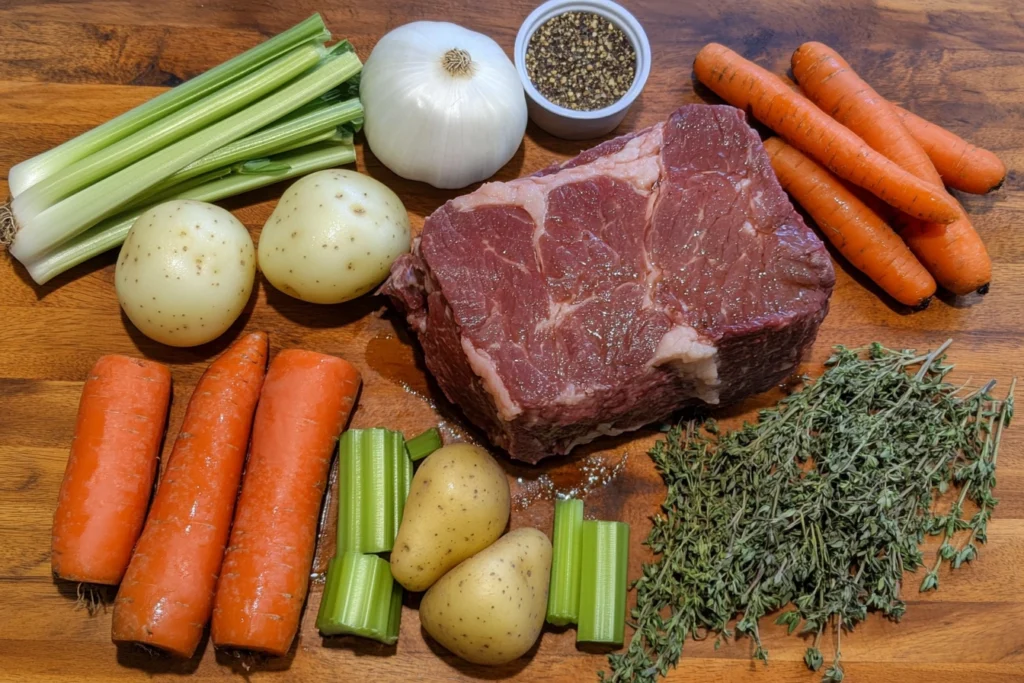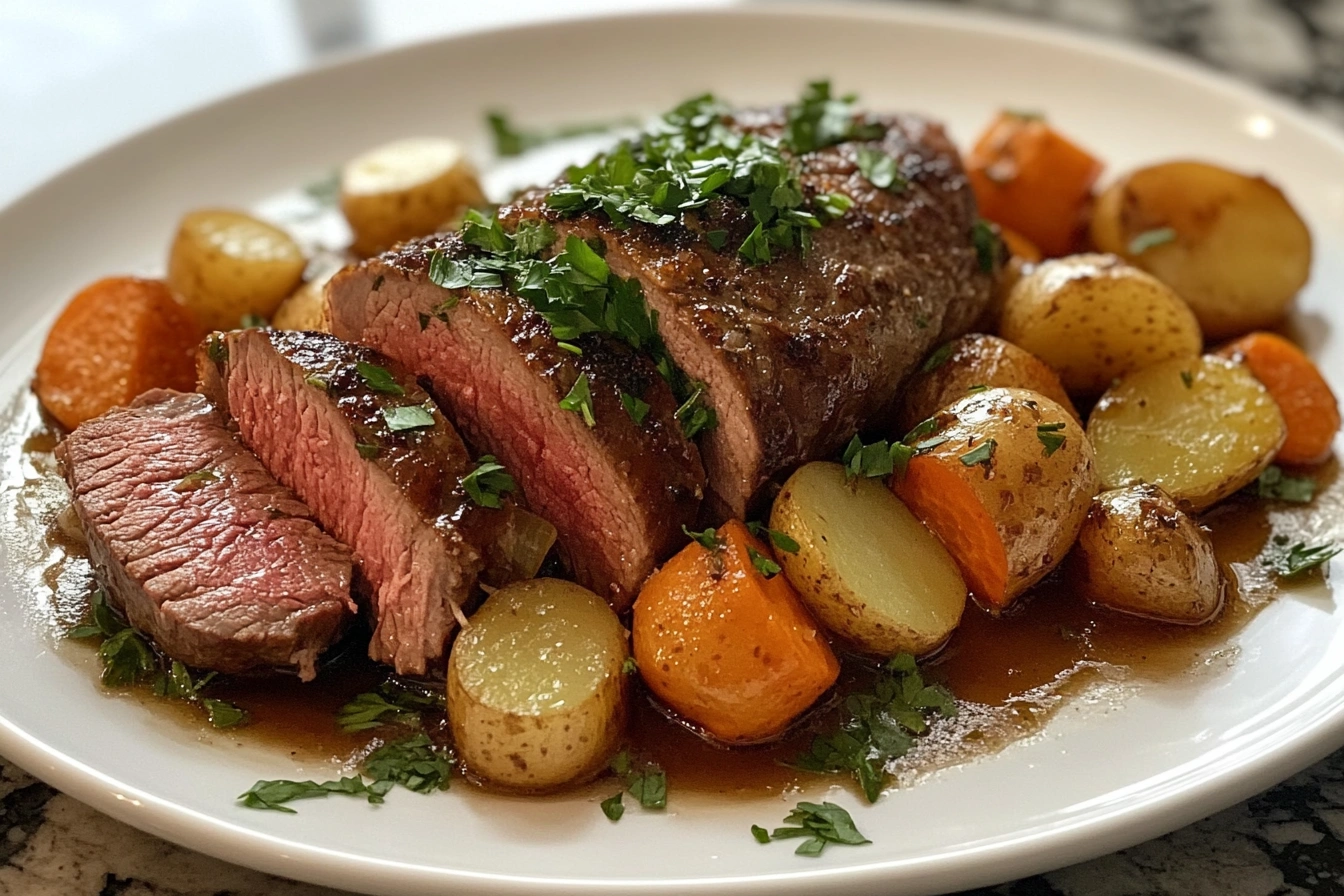Introduction
A stove top pot roast is the epitome of comfort food, blending tender beef, hearty vegetables, and rich flavors into a one-pot masterpiece. This classic dish is perfect for family dinners or special occasions, offering a homestyle experience without the need for an oven. For a delightful twist on traditional flavors, consider pairing your pot roast with recipes like Avocado and Roast Chicken Recipes or a Honey Pineapple Baked Chicken Recipe.
Ingredients Needed for Stove Top Pot Roast
The Essential Components
Choosing the Right Cut of Beef
- Chuck Roast: The go-to choice for its marbled fat, which renders beautifully during cooking, ensuring a tender and juicy result.
- Brisket: A slightly leaner option, great for those who prefer a firmer texture.
- Round Roast: A budget-friendly alternative that still delivers a satisfying flavor.
Vegetables for Texture and Flavor
- Carrots: Add natural sweetness and color to the dish.
- Potatoes: Choose waxy potatoes like Yukon Gold or red potatoes to hold their shape during cooking.
- Onions: Provide a savory base for the dish. Yellow onions are a classic choice.
- Celery: Adds subtle flavor and texture to the mix.
Broth and Liquids
- Beef Broth: Enhances the meaty flavor and forms the base for the gravy.
- Optional Additions: Use tomato paste or Worcestershire sauce for added depth.
Seasonings and Herbs
- Salt and Pepper: The essentials for seasoning both the meat and vegetables.
- Garlic: Fresh cloves or minced garlic for aromatic depth.
- Herbs: Thyme, rosemary, or bay leaves elevate the flavor profile.
Equipment Required for Stove Top Pot Roast
The Must-Have Tools for Success
1. Dutch Oven or Heavy-Bottomed Pot
- Why It’s Essential: A heavy-duty pot like a Dutch oven distributes heat evenly, preventing hotspots and ensuring the roast cooks uniformly. Its tight-fitting lid helps lock in moisture, creating the perfect environment for tender meat.
- Alternative Options: If you don’t have a Dutch oven, a large stockpot with a sturdy base works well.
2. Tongs
- Purpose: Tongs are crucial for handling the roast during searing and for flipping vegetables while sautéing. They provide better control than a spatula.
3. Ladle or Large Spoon
- Purpose: Used for stirring the broth and basting the roast during cooking to keep it moist and flavorful.
4. Meat Thermometer
- Why It’s Important: A meat thermometer ensures your roast reaches the ideal internal temperature for tenderness (about 190–200°F for a pot roast).
5. Cutting Board and Sharp Knife
- Purpose: A sturdy cutting board is necessary for trimming the beef before cooking and slicing the finished roast. A sharp knife makes precise cuts easier.
6. Wooden Spoon or Silicone Spatula
- Why You Need It: Perfect for deglazing the pot and scraping up the browned bits that add flavor to the gravy.

Step-by-Step Guide to Preparing Stove Top Pot Roast
1. Preparing the Meat
Trimming the Roast
- Remove any large pieces of excess fat from the beef, but leave enough to keep the roast moist and flavorful during cooking.
Seasoning the Roast
- Generously coat the roast with salt, pepper, and a light dusting of garlic powder. Let it rest for 15–20 minutes to absorb the seasoning.
2. Searing the Roast
Why Searing Matters
- Searing creates a flavorful crust and locks in the juices, enhancing the overall taste of your stove top pot roast.
Steps to Sear
- Heat 2 tablespoons of oil in your Dutch oven over medium-high heat.
- Add the roast and sear each side for 3–4 minutes until golden brown.
- Remove the roast and set it aside.
3. Sautéing the Vegetables
Enhancing the Base Flavor
- Add chopped onions, carrots, and celery to the pot.
- Cook for 5–7 minutes, stirring occasionally, until the vegetables soften and develop a slight caramelization.
Adding Garlic
- Add minced garlic during the last minute of sautéing for an aromatic boost.
4. Deglazing the Pot
The Importance of Deglazing
- Deglazing lifts the browned bits (fond) stuck to the bottom of the pot, which are packed with flavor.
How to Deglaze
- Pour 1/2 cup of beef broth or red wine into the pot.
- Use a wooden spoon to scrape up the browned bits as the liquid simmers.
5. Simmering the Roast
Placing the Roast Back in the Pot
- Return the seared roast to the pot, nestling it among the sautéed vegetables.
Adding Liquids
- Pour in enough beef broth to cover the roast halfway.
- Add herbs like thyme, rosemary, or a bay leaf for extra flavor.
Cooking Time and Temperature
- Reduce the heat to low, cover the pot, and simmer for 2–3 hours. Check occasionally to ensure the liquid is gently bubbling.
6. Adding the Vegetables
Timing Is Key
- Add potatoes and carrots during the last hour of cooking. This ensures they remain tender without becoming mushy.
Layering for Even Cooking
- Arrange the vegetables around and on top of the roast, ensuring even heat distribution.
7. Checking for Doneness
Using a Meat Thermometer
- Insert the thermometer into the thickest part of the roast. The internal temperature should reach 190–200°F for the beef to be tender and easy to shred.
Testing Vegetables
- Use a fork to check if the potatoes and carrots are cooked through.
8. Resting and Serving
Letting the Roast Rest
- Remove the pot from heat and let the roast rest for 10–15 minutes. This allows the juices to redistribute.
Slicing and Serving
- Slice the roast against the grain for maximum tenderness. Serve with the vegetables and ladle the rich gravy over the top.
Tips for the Perfect Stove Top Pot Roast
1. Maintain the Right Temperature
Why Low and Slow is Key
- Cooking the roast over low heat ensures the beef becomes tender without drying out. A gentle simmer allows the flavors to develop fully.
Avoid Boiling
- Keep the liquid at a low bubble. Boiling can toughen the meat and overcook the vegetables.
2. Adjust Seasonings Throughout Cooking
Taste as You Go
- As the roast cooks, the flavors intensify. Periodically taste the broth and adjust salt, pepper, or herbs as needed.
Enhance Depth with Add-Ins
- Add a splash of Worcestershire sauce or soy sauce for an umami boost during the last 30 minutes of cooking.
3. Thickening the Gravy
Using Cornstarch Slurry
- Mix 1 tablespoon of cornstarch with 2 tablespoons of cold water. Stir the mixture into the simmering broth to thicken the gravy.
Flour Option
- For a richer consistency, whisk 1 tablespoon of flour into 2 tablespoons of melted butter before adding it to the pot.
4. Keep Vegetables Firm, Not Mushy
Perfect Timing
- Add hearty vegetables like carrots and potatoes later in the cooking process to avoid overcooking.
Cut Uniform Pieces
- Chop vegetables into similar sizes to ensure even cooking.
5. Resting for Maximum Tenderness
Why Resting Matters
- Allowing the roast to rest for 10–15 minutes helps retain its juices, making each slice flavorful and moist.
6. Save the Leftover Broth
Multiple Uses
- The broth from the pot is packed with flavor. Use it as a soup base, a sauce for pasta, or a dip for bread.
Variations and Substitutions
1. Alternative Meats
For those who prefer lighter options, try a Roast Chicken with Vegetables, which complements the hearty flavors of a pot roast beautifully.
Pork Shoulder
- Why It Works: Pork shoulder’s rich marbling ensures a tender and flavorful result.
- Cooking Tip: Use the same low-and-slow method as for beef, but check for doneness at an internal temperature of 190°F.
Lamb Shank
- Flavor Profile: Adds a unique, savory depth to the dish.
- Herbs to Pair: Rosemary and mint complement lamb beautifully.
2. Vegetarian Pot Roast
If you’re exploring vegetarian options, these techniques can also inspire your cooking. For instance, hearty vegetable roasts often share preparation methods with dishes like Avocado and Roast Chicken Recipes.
Hearty Vegetables
- Substitute meat with large chunks of root vegetables like turnips, parsnips, and sweet potatoes.
- Add mushrooms for a meaty texture and earthy flavor.
Plant-Based Protein Options
- Use tofu, tempeh, or jackfruit as a meat alternative.
Broth Adjustments
- Swap beef broth for vegetable stock and add soy sauce for richness.
3. International Flavor Enhancements
French-Inspired
- Add a splash of red wine and fresh thyme to create a Boeuf Bourguignon twist.
- Serve with crusty French bread.
Asian-Inspired
- Incorporate soy sauce, ginger, and star anise into the broth.
- Serve with steamed rice or noodles instead of potatoes.
Mediterranean Touch
- Use olive oil instead of butter, and add sun-dried tomatoes, olives, and oregano to the mix.
4. Health-Conscious Adjustments
Low-Sodium Option
- Use low-sodium broth and season sparingly with salt. Enhance flavor with herbs and spices instead.
Low-Carb Version
- Replace potatoes with cauliflower florets or turnips for a lower-carb alternative.
Dairy-Free
- Skip the butter and use olive oil for searing and thickening.
5. Creative Gravy Variations
Tomato-Based Gravy
- Add canned diced tomatoes or tomato paste to the broth for a tangy twist.
Creamy Mushroom Sauce
- Sauté mushrooms separately, then blend them into the broth with a splash of coconut milk or cream.
Serving Suggestions for Stove Top Pot Roast
1. Side Dishes to Complement the Roast
Classic Options
- Mashed Potatoes: Creamy mashed potatoes pair perfectly with the rich gravy from the roast.
- Buttered Green Beans: Add freshness and a pop of color to the plate.
- Roasted Brussels Sprouts: Crispy and caramelized, they balance the hearty flavors.
Hearty Additions
- Crusty Bread: Use it to soak up the flavorful broth or gravy.
- Cornbread: Adds a sweet and crumbly contrast to the savory roast.
- Rice or Quinoa: A neutral base to complement the rich flavors.
2. Beverage Pairings
Non-Alcoholic Options
- Sparkling Water with Lemon: A light, refreshing choice.
- Iced Tea: Pairs well with the savory and hearty nature of the dish.
- Hot Apple Cider: Perfect for colder weather and a comforting meal.
For Special Occasions
- Choose a mocktail like a cranberry spritzer or a virgin mojito to add an elegant touch.
3. Leftover Ideas
Pot Roast Sandwiches
- Shred the leftover meat and layer it on a crusty roll with a dollop of gravy or mustard.
Pot Roast Soup
- Combine the remaining roast, vegetables, and broth with extra water or stock for a hearty soup.
Tacos or Wraps
- Use shredded roast as a filling for soft tortillas, topped with fresh salsa and shredded lettuce.
4. Plating and Presentation Tips
Layering for Visual Appeal
- Arrange the meat slices in the center, surrounded by the vegetables, and drizzle gravy on top.
Garnishing
- Sprinkle chopped parsley or thyme over the dish for a fresh and vibrant finish.
Serving Style
- Present the pot roast in the Dutch oven or pot for a rustic, family-style meal.
Common Mistakes to Avoid When Making Stove Top Pot Roast
1. Overcooking or Undercooking the Roast
What Happens
- Overcooking makes the meat dry and stringy, while undercooking leaves it tough.
How to Avoid It
- Use a meat thermometer to ensure the internal temperature reaches 190–200°F for tender, shred-worthy beef.
2. Skipping the Searing Step
Why It’s Important
- Searing locks in the meat’s juices and adds a caramelized crust for extra flavor.
Solution
- Always sear the roast on medium-high heat before adding liquid and vegetables.
3. Boiling Instead of Simmering
What Happens
- Boiling leads to uneven cooking and tough meat.
How to Fix It
- Keep the broth at a gentle simmer by maintaining low heat and checking regularly.
4. Adding Vegetables Too Early
Why It’s a Problem
- Vegetables like carrots and potatoes can become mushy if cooked too long.
Solution
- Add vegetables during the last hour of cooking to maintain their texture.
5. Neglecting to Deglaze the Pot
Missed Opportunity
- Skipping deglazing means leaving behind flavorful browned bits stuck to the pot.
Fix It
- Use beef broth or wine to scrape up the browned bits after searing for a richer gravy.
6. Overcrowding the Pot
The Problem
- Too many ingredients can lead to uneven cooking and reduced flavor concentration.
Solution
- Ensure the roast fits snugly with room for vegetables to cook evenly without overcrowding.
7. Forgetting to Rest the Meat
Why It’s Crucial
- Cutting the roast immediately after cooking causes juices to escape, resulting in dry meat.
What to Do
- Allow the roast to rest for 10–15 minutes before slicing.
8. Not Using Enough Seasoning
The Impact
- Under-seasoned broth leads to a bland dish.
Fix It
- Taste and adjust seasonings during cooking, adding herbs and spices as needed.
Frequently Asked Questions (FAQs)
1. What is the best cut of meat for stove top pot roast?
- Answer: Chuck roast is the most popular choice due to its marbling, which creates tender and juicy meat. Brisket and round roast are also good options, depending on your preference for texture and fat content.
2. Can I make stove top pot roast without a Dutch oven?
- Answer: Yes! A heavy-bottomed stockpot or a large saucepan with a tight-fitting lid works just as well. Just ensure the pot is large enough to hold all the ingredients.
3. How do I prevent my pot roast from becoming dry?
- Answer: Simmer the roast in enough liquid to cover at least halfway and maintain a low, steady heat. Also, avoid skipping the searing step, as it helps lock in moisture.
4. Can I make this recipe gluten-free?
- Answer: Absolutely! Use gluten-free broth and thicken the gravy with cornstarch instead of flour. Double-check that any seasoning mixes are gluten-free.
5. How long does it take to cook a pot roast on the stove?
- Answer: It typically takes 2–3 hours to cook a pot roast on the stove. The exact time depends on the size of the roast and the temperature maintained during simmering.
6. What vegetables can I add to the pot roast?
- Answer: In addition to potatoes, carrots, and onions, you can add parsnips, turnips, mushrooms, or even sweet potatoes for variety.
7. Can I use frozen meat for stove top pot roast?
- Answer: It’s best to thaw the meat before cooking to ensure even cooking and proper seasoning. If you’re in a pinch, use a longer cooking time and start on low heat.
8. How do I store leftovers?
- Answer: Transfer leftovers to an airtight container and refrigerate for up to 3 days. For longer storage, freeze portions with the gravy for up to 3 months.
9. How do I reheat pot roast?
- Answer: Reheat on the stove in a small pot with a splash of broth to keep the meat moist. Alternatively, use a microwave, covering the roast to prevent it from drying out.
10. Can I use wine in my pot roast?
- Answer: Yes! Red wine adds depth to the broth. Simply replace 1/2 to 1 cup of broth with your favorite red wine during the deglazing step.
Conclusion
A stove top pot roast is more than just a meal—it’s a comforting tradition that brings people together around the table. With its tender meat, rich gravy, and hearty vegetables, this dish is a celebration of flavors and textures. By following this guide, you can confidently prepare a pot roast that’s both delicious and satisfying, whether it’s for a family dinner or a special occasion.
Key Takeaways
- Start with Quality Ingredients: Selecting the right cut of beef and fresh vegetables is the foundation of a great pot roast.
- Master the Process: Searing, deglazing, and slow simmering are essential steps to achieving tender, flavorful results.
- Customize with Variations: Explore different meats, flavor profiles, and sides to make the recipe your own.
- Avoid Common Mistakes: With proper preparation and attention to detail, your pot roast will turn out perfectly every time.
Encouragement to Try the Recipe
Don’t be intimidated—making a stove top pot roast is easier than you think! With this step-by-step guide, you have all the tools and tips to create a dish that will impress your family and friends. Experiment with variations, enjoy the process, and savor the rewards of your efforts.
Share Your Success
Once you’ve perfected your pot roast, share your creation with loved ones or post your masterpiece on social media to inspire others. After all, food is meant to be shared and celebrated.
Enjoy the comforting aroma, hearty flavors, and satisfaction of cooking a timeless classic. Happy cooking!

